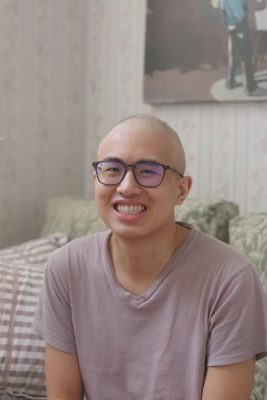P’ville Grad Battles Through Leukemia, Hopes for Bone Marrow Match

Many people are waiting and hoping for a vaccine or medical treatments to put an end to the COVID-19 pandemic.
Andrew Tom is waiting to be notified of a match to have a bone marrow transplant.
Tom recently returned to his native Pleasantville with his fiancée to be near family as he wages a battle against mixed phenotype acute leukemia (MPAL), a rare and aggressive form of the disease. He was diagnosed in May in San Francisco, where he had lived for the past four years working for a hedge fund, after experiencing swollen lymph nodes, followed by nosed bleeds, sensitivity to bright light and migraines.
“It was a tough thing to accept and even though so much has happened, I feel like, even reflecting on it now, not a lot of time has actually passed,” said Tom, 29, a 2009 Pleasantville High School graduate. “It’s only really like a month or so.”
While Tom had undergone chemotherapy during a 40-day stay at UCSF Medical Center in San Francisco, his best chance at not only survival but long-term health is to receive a bone marrow transplant. His brother and sister are half-matches, which is not ideal and would expose him to risks that a full match would not.
Even if everything works out well and a full match is found, Tom faces a potentially physically challenging road ahead. Last week he received a bone marrow biopsy; if the biopsy reveals that there’s still leukemia, he would need another round of chemotherapy. If the disease is in remission, then Tom and his doctors at Memorial Sloan Kettering Cancer Center can start the search for a match and hopefully begin the procurement process, he said.
“I need to wipe out all of my bone marrow in order to supplant it with a healthy person’s bone marrow,” explained Tom.
Should a match be found, it would require four days of radiation therapy and three days of chemotherapy in order to do that, he said. Then the doctors would start with the transplant intravenously. There will be a period of time that his red and white blood cells will essentially be at zero, which would require blood transfusions for several weeks.
Following that, there will be outpatient visits about three times a week to Sloan Kettering. The idea is to increase the potential of the bone marrow taking over the next one to two years, after which success increases dramatically.
The schedule assumes there aren’t any disruptions to schedules because of a re-emergence of COVID-19 cases in the region, he said.
Tom’s youth and good health before he was diagnosed signaled to him and his doctors that he would be able to handle the transplant and the most aggressive approach as opposed to an older person, who would likely be treated through chemotherapy.
“These are short-term issues that you have to work through, which creates long-term probability, even by a few percentage points,” Tom said. “It’s just an unfortunate tradeoff that my doctors and I philosophically agree with.”
His sister, Jessica, said Andrew’s prognosis is good since he is young, has no other underlying health issues and the cancer hasn’t spread.
The large unknown is how long he will be able to wait for a transplant. She said Andrew is currently in remission and can be sustained through therapies until a donor is found.
“However, this is merely treading water and a bone marrow transplant is the best and surest way to cure him,” Jessica said.
A hurdle for Tom to overcome is that the chance for patients of Chinese descent finding a suitable match is lower than Caucasian people, she said. Only 0.7 percent of the national registry for donors is Chinese.
While a donor does not have to be Chinese, there is a greater chance of a match with someone from the same ethnic group, Jessica said. That stresses the importance of having as many people register as possible with the National Bone Marrow Donor Program by getting their cheek swabbed.
Despite all of the challenges, including losing his hair and being tethered to tubes, Tom remains upbeat.
“It’s unfortunate but I like to think I’ve done my homework, I’ve set myself up with the best doctors at the best facilities,” Tom said. “I have good insurance coverage; I have family infrastructure to help support me.”
For information about registered with the National Bone Marrow Donor Program, visit join.bethematch.org/swabforandrew. For more information on Andrew Tom, visit www.swabforandrew.com.

Martin has more than 30 years experience covering local news in Westchester and Putnam counties, including a frequent focus on zoning and planning issues. He has been editor-in-chief of The Examiner since its inception in 2007. Read more from Martin’s editor-author bio here. Read Martin’s archived work here: https://www.theexaminernews.com/author/martin-wilbur2007/
